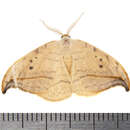Conservation Status
provided by University of Alberta Museums
A fairly common widespread species; no concerns.
- license
- cc-by-nc
- copyright
- University of Alberta Museums
Cyclicity
provided by University of Alberta Museums
In Alberta adults are on the wing from mid-May through late-July.
- license
- cc-by-nc
- copyright
- University of Alberta Museums
Distribution
provided by University of Alberta Museums
Newfoundland to Vancouver Island, south to at least the Carolinas and California (?). In Alberta it can be found throughout the Boreal forest region, north to Bitumount and Zama, as well as in the foothills and mountain regions.
- license
- cc-by-nc
- copyright
- University of Alberta Museums
General Description
provided by University of Alberta Museums
Hooktips are medium-size broad-winged geometrid-like moths with the forewing apex drawn out into a prominent curved point. The Arched Hook tip (2.4- 4.0 cm wingspan) is yellow-brown or light tan. The forewings are crossed by a series of toothed fine brown lines, with a darker curved line running from the lower margin to the hooked apex, and with two small dark dots in the discal area. The outer margins of the forewings are smooth (toothed in D. bilineata). The hindwings are white or very pale yellow-brown, faintly and incompletely crossed by a series of fine light brown bands. The sexes are similar. The related Two-lined Hooktip (D. bilineata) has darker tan forewings with toothed margins, each crossed by only two fine dark brown lines. The hindwings are unmarked or nearly so. The Rose Hooktip (Oreta rosea) is darker and two-toned dark brown or purple-brown and yellow.
- license
- cc-by-nc
- copyright
- University of Alberta Museums
Habitat
provided by University of Alberta Museums
Deciduous woodland with birch or alder.
- license
- cc-by-nc
- copyright
- University of Alberta Museums
Life Cycle
provided by University of Alberta Museums
The Arched Hookedtip is nocturnal and comes to light. There is a single brood each year. The larvae are solitary defoliators.
- license
- cc-by-nc
- copyright
- University of Alberta Museums
Trophic Strategy
provided by University of Alberta Museums
No specific Alberta data. Elsewhere in Canada reported to utilize White Birch (Betula papyrifera) and alder (Alnus sp.) as larval hosts (Prentice, 1963).
- license
- cc-by-nc
- copyright
- University of Alberta Museums
Drepana arcuata
provided by wikipedia EN
Drepana arcuata, the arched hooktip or masked birch caterpillar, is a moth of the family Drepanidae. The species was first described by Francis Walker in 1855.[1] It is found from Newfoundland to Vancouver Island, south to at least North Carolina, South Carolina and California.
The wingspan is 24–40 millimetres (0.94–1.57 in). Adults are on wing from mid-May through late-July. There is one generation per year in the north.
The larvae feed on Betula papyrifera and Alnus species, which they may use as a medium to communicate. Sound is produced by shaking their bodies, drumming and scraping their mouthparts, or dragging specialised anal "oars" against the surface of a leaf. Larvae build communal silk shelters and the sounds may attract other larva to the shelter.[2]
References

- license
- cc-by-sa-3.0
- copyright
- Wikipedia authors and editors
Drepana arcuata: Brief Summary
provided by wikipedia EN
Drepana arcuata, the arched hooktip or masked birch caterpillar, is a moth of the family Drepanidae. The species was first described by Francis Walker in 1855. It is found from Newfoundland to Vancouver Island, south to at least North Carolina, South Carolina and California.
The wingspan is 24–40 millimetres (0.94–1.57 in). Adults are on wing from mid-May through late-July. There is one generation per year in the north.
The larvae feed on Betula papyrifera and Alnus species, which they may use as a medium to communicate. Sound is produced by shaking their bodies, drumming and scraping their mouthparts, or dragging specialised anal "oars" against the surface of a leaf. Larvae build communal silk shelters and the sounds may attract other larva to the shelter.
- license
- cc-by-sa-3.0
- copyright
- Wikipedia authors and editors

